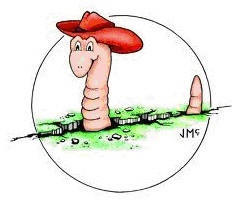 The reddish-gray-colored common earthworm, often called a night crawler in the United States, is familiar to anyone with a fishing rod or a garden. They are indigenous to Europe, but are now abundant in North America and western Asia.
The reddish-gray-colored common earthworm, often called a night crawler in the United States, is familiar to anyone with a fishing rod or a garden. They are indigenous to Europe, but are now abundant in North America and western Asia.
Typically only a few inches in length, some members of this species have been known to grow to 14 inches. Earthworms’ bodies are made up of ring-like segments called annuli. These segments are covered in setae, or small bristles, which the worm uses to move and burrow.
Night crawlers are so named because they are usually seen feeding above ground at night. They burrow during the day—typically keeping close to the surface—capable of digging down as deep as 6.5 feet . The earthworm is an herbivore that is a member of the invertebrate family. Its life span in the wild can average 6 years. Contrary to popular legend, if divided into 2
segments, one earthworm doesn’t turn into two earthworms!
 The worm’s first segment contains its mouth. As they burrow, they consume soil, extracting nutrients from decomposing organic matter like leaves and roots. Earthworms are vital to soil health because they transport nutrients and minerals from below to the surface via their waste, and their tunnels aerate the
ground. An earthworm eats up to one third its body weight in a day.
The worm’s first segment contains its mouth. As they burrow, they consume soil, extracting nutrients from decomposing organic matter like leaves and roots. Earthworms are vital to soil health because they transport nutrients and minerals from below to the surface via their waste, and their tunnels aerate the
ground. An earthworm eats up to one third its body weight in a day.
Night crawlers also mate on the surface. They are hermaphroditic but do not self-fertilize; they are sexually active at about a year of age. Following mating, each worm forms a tiny, lemon-shaped cocoon out of a liquid secreted from its clitellum, the familiar-looking bulge seen near the first third of the earthworm’s body. The sperm and egg cells are deposited inside
the cocoon buried beneath the soil. After a two- to four-week gestation period, the baby worms emerge. Those who dwell near the earth’s surface generally produce 2 cocoons per year, with 1-2 young worms per cocoon. However, deeper dwellers produce more young because their habitat is in a safer environment that that atop the soil.
The earthworm’s numbers are strong throughout their range—they’re even considered agricultural pests in some areas. However, here in the Northeast, earthworms are very desirable. Many soils are clay or shale, perhaps further compacted by heavy equipment on building sites. These little aerators do a great job of enhancing soil quality through increased drainage and
single-handedly provide compost through the process of worm elimination.
Earthworms are really more than just fish bait. They are the main contributors to enriching and improving soil for plants, animals and even humans. Earthworms create tunnels in the soil by burrowing, which aerates the soil to allow air, water and nutrients to reach deep within the soil. Earthworms eat the soil which has organic matter such as decaying vegetation or
leaves. Plants cannot use this organic matter directly.
Not only does the earthworm have several hearts, it also has a gizzard! Soil enters the earthworm’s mouth where it is swallowed by the pharynx. Then the soil passes through the esophagus, which has calciferous glands that release calcium carbonate to rid the earthworm’s body of excess calcium. After it passes through the esophagus, food moves into the crop where it is
stored and then eventually moves into the gizzard which uses stones that the earthworm eats to grind the food completely.
The little guys have no lungs, but rather breathe through their skin. They have no eyes, but sense light and touch through receptor cells. Their enemies include moles, snakes, birds, toads and even foxes. Depending on other food sources, beetles and slugs can feed on earthworms.
After organic matter is digested, the earthworm releases a waste product referred to as "castings". These castings contain nutrients the plant can use. Some people use earthworm castings as their garden fertilizer of choice. Earthworm castings are available on the retail market and this writer has had success using them to supplement outdoor plants. At the urging of a
"castings" vendor, I tested two identical potted plants with castings against my favorite liquid fertilizer; results were very similar. Castings are not messy at all, but rather dry pellets; they are not as readily available le as other more common fertilizers, so are not as widely used.
Earthworms are a sign of healthy soil. They don’t survive in very dry soil and may drown in soil that holds too much moisture. If you see your friend, the earthworm, wiggling in your garden, resist the urge to use him as fish bait. He is doing his best to improve your soil quality!
Read other articles about controlling insects & garden pests
Read other articles by Kay Hinkle